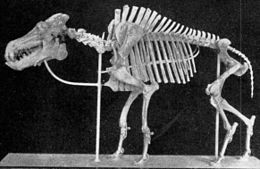Daeodon
| Daeodon | ||||||||||||||||||||||||||||||||||||
|---|---|---|---|---|---|---|---|---|---|---|---|---|---|---|---|---|---|---|---|---|---|---|---|---|---|---|---|---|---|---|---|---|---|---|---|---|
| Evolúciós időszak: Középső oligocén - kora miocén, 29–19 Ma | ||||||||||||||||||||||||||||||||||||
 A Daeodon csontváza
| ||||||||||||||||||||||||||||||||||||
| Természetvédelmi státusz | ||||||||||||||||||||||||||||||||||||
| Fosszilis | ||||||||||||||||||||||||||||||||||||
| Rendszertani besorolás | ||||||||||||||||||||||||||||||||||||
| ||||||||||||||||||||||||||||||||||||
| Szinonimák | ||||||||||||||||||||||||||||||||||||
| ||||||||||||||||||||||||||||||||||||
| Hivatkozások | ||||||||||||||||||||||||||||||||||||
A Wikimédia Commons tartalmaz Daeodon témájú kategóriát. |
A Daeodon az emlősök (Mammalia) osztályának párosujjú patások (Artiodactyla) rendjébe, ezen belül a fosszilis Entelodontidae családjába tartozó nem.
Tudnivalók
[szerkesztés]A Daeodon (korábban Dinohyus, jelentése: „szörnyű disznó”),[1] az Entelodontidae-k között a legnagyobb volt. Észak-Amerikában élt körülbelül 29-19 millió évvel ezelőtt.
Az állat marmagassága 177 centiméter, a koponyahossza pedig 90 centiméter lehetett.[2] A Daeodon hasonlított egy óriás, szörnyszerű disznóhoz vagy varacskosdisznóhoz. Hatalmas állkapcsából nagy agyarak álltak ki, pofacsontja pedig kiemelkedett. Az állatot az Agate Springs Quarry nevű lelőhelynél találták meg.[3] Maradványai arra utalnak, hogy az állat egyaránt dögevő, de vadász is volt. Koponyáján és alsó állkapcsán csontos kinövések voltak, olyanok, mint a mai varacskosdisznónál. Ezek a kinövések tartották az erős izmokat.
Rendszerezés
[szerkesztés]A nembe az alábbi 1-2 faj tartozik:
- Daeodon shoshonensis Cope, 1878 - típusfaj
- ?Daeodon humerosum Cope, 1879 - szinonimája: Boochoerus humerosum
Képek
[szerkesztés]-
A Daeodon koponyája közelről
-
A Daeodon shoshonensis rekonstrukciója
-
A Daeodon shoshonensis mérete az emberhez viszonyítva
Jegyzetek
[szerkesztés]- ↑ Lucas, S.G., Emry, R.J., and Foss, S.E. (1997). "Taxonomy and distribution of Daeodon, an Oligocene-Miocene entelodont (Mammalia: Artiodactyla) from North America." Proceedings of the Biological Society of Washington, 111(2): 425-435.
- ↑ Peterson, O. A. (1909). „A revision of the Entelodontidae”. Memoirs of the Carnegie Museum 4 (3), 41–158. o.
- ↑ Prothero, Donald R. (2005). "After the dinosaurs. The age of mammals".
Források
[szerkesztés]- Paleobiology Database[halott link]
- Brown, R. W. (1954). Composition of scientific words: A manual of methods and a lexicon of materials for the practice of logotechnics. Smithsonian Institution Press. ISBN 978-0874740011.
- Cope, E. D. (1878). "On some characters of the Miocene fauna of Oregon". Paleontological Bulletin. 30: 1–16.
- Sinclair, W. J. (1905). "New and imperfectly known rodents and ungulates from the John Day Series". Bull. Dept. Geology, Univ. California. 4: 132–134.
- Peterson, O. A. (1909). "A revision of the Entelodontidae". Memoirs of the Carnegie Museum. 4 (3): 41–158.
- Lucas, S.G.; Emry, R.J.; Foss, S.E. (1998). "Taxonomy and distribution of Daeodon, an Oligocene-Miocene entelodont (Mammalia: Artiodactyla) from North America". Proceedings of the Biological Society of Washington. 111 (2): 425–435.
- Foss, S. E.; Fremd, T. J. (2001). "Biostratigraphy of the Entelodontidae (Mammalia: Artiodactyla) from the John Day Basin, Oregon". Paleobios. 21: 53.
- Donald R. Prothero; Scott. E. Foss (2007). The Evolution of Artiodactyls. JHU Press.
- Allen, G. M. (1926). "Fossil mammals from South Carolina". Bulletin of the Museum of Comparative Zoology. 67: 447–467.
- Loomis, F. B. (1932). "Two new Miocene entelodonts". Journal of Mammalogy. 13: 358–362. doi:10.2307/1374141.
- Simpon, G. G. (1945). "The principles of classification and a classification of mammals". Bulletin of the American Museum of Natural History. 85: 1–350.
- Peterson, O. A. (1905b). "A correction of the generic name (Dinochoerus) given to certain fossil remains from the Loup Fork Miocene of Nebraska". Science. 22: 719. doi:10.1126/science.22.570.719. PMID 17729479.
- Peterson, O. A. (1905a). "Preliminary note on a gigantic mammal from the Loup Fork Beds of Nebraska". Science. 22: 211–212. doi:10.1126/science.22.555.211. PMID 17835750.
- Foss, S. E.; Fremd, T. (1998). "A survey of the species of Entelodonts (Mammalia, Artiodactyla) of the John Day Basin, Oregon". Dakoterra. 5: 63–72.
- Effinger, J. A. (1998). "Entelodontidae". In Janis, C. M.; Scott, K. M.; Jacobs, L. L. Evolution of Tertiary Mammals of North America. Volume 1: Terrestrial Carnivores, Ungulates, and Ungulatelike Mammals. Cambridge University Press.
Fordítás
[szerkesztés]- Ez a szócikk részben vagy egészben a Daeodon című angol Wikipédia-szócikk ezen változatának fordításán alapul. Az eredeti cikk szerkesztőit annak laptörténete sorolja fel. Ez a jelzés csupán a megfogalmazás eredetét és a szerzői jogokat jelzi, nem szolgál a cikkben szereplő információk forrásmegjelöléseként.




